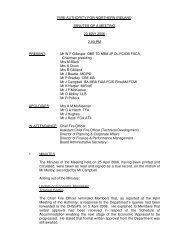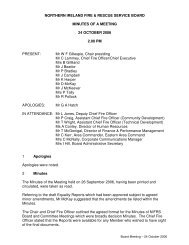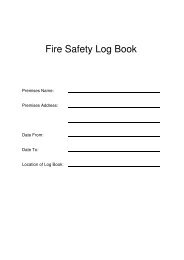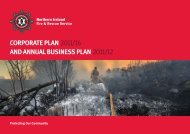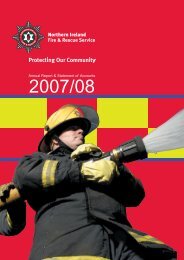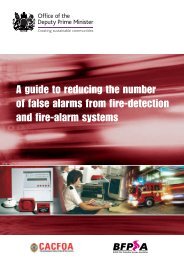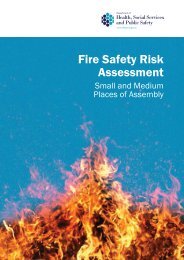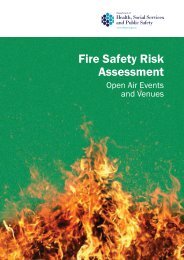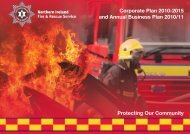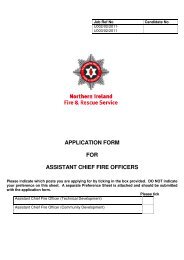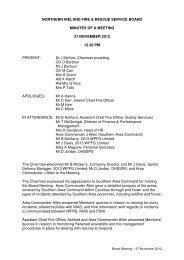Priorities and Targets - Northern Ireland Fire & Rescue Service
Priorities and Targets - Northern Ireland Fire & Rescue Service
Priorities and Targets - Northern Ireland Fire & Rescue Service
Create successful ePaper yourself
Turn your PDF publications into a flip-book with our unique Google optimized e-Paper software.
<strong>Priorities</strong> <strong>and</strong> <strong>Targets</strong><br />
Corporate Plan<br />
2008-2013<br />
<strong>and</strong><br />
Annual Business Plan<br />
2008/09<br />
<strong>Northern</strong> Irel<strong>and</strong><br />
<strong>Fire</strong> & <strong>Rescue</strong> <strong>Service</strong>
Contents<br />
Pages<br />
Foreword by Chief <strong>Fire</strong> Officer 2<br />
Vision, Mission <strong>and</strong> Core Values 3<br />
Who We Are <strong>and</strong> What We Do 4<br />
Key Achievements for 2007/2008 5-6<br />
Corporate <strong>and</strong> Business Plans 7<br />
Measuring Progress <strong>and</strong> Performance 8<br />
National <strong>and</strong> Local Influences 9<br />
National Frameworks 10<br />
Key Themes 11-22<br />
Corporate Plan 2008-2013 23-30<br />
Annual Business Plan 2008/09 31-52<br />
1
1<br />
Foreword by<br />
Chief <strong>Fire</strong> Officer<br />
I am pleased to present the <strong>Northern</strong> Irel<strong>and</strong><br />
<strong>Fire</strong> & <strong>Rescue</strong> <strong>Service</strong> <strong>Priorities</strong> <strong>and</strong> <strong>Targets</strong><br />
Corporate Plan 2008-2013 <strong>and</strong> Annual<br />
Business Plan 2008/09. This plan sets out how<br />
we will respond in the coming years to the ever<br />
changing challenges we face as we work<br />
towards meeting the needs of our community.<br />
We are committed to making <strong>Northern</strong> Irel<strong>and</strong> a<br />
safer place for everyone who lives, works or<br />
visits here. That commitment goes far beyond<br />
our traditional role of responding to fires <strong>and</strong><br />
carrying out fire prevention work to cover our<br />
much wider responsibilities including road<br />
traffic collisions <strong>and</strong> accidents, chemical<br />
emergencies, major accident hazards, rescues<br />
<strong>and</strong> large scale emergencies. We need to<br />
continue to work in partnership with others.<br />
NIFRS has demonstrated high levels of<br />
commitment, professionalism <strong>and</strong> flexibility.<br />
Over the past year we have continued to<br />
develop <strong>and</strong> improve the way we serve our<br />
community. The number of injuries in fires <strong>and</strong><br />
the number of deliberate property fires (arson)<br />
have continually decreased over the past few<br />
years. This is due to the ongoing efforts of our<br />
staff to reduce risk by education, <strong>and</strong> taking<br />
positive actions with particular risk groups<br />
including vulnerable adults, children <strong>and</strong> young<br />
people. It is therefore vital that we continue to<br />
implement our Community Safety Initiatives in<br />
order to continue this downward trend.<br />
Going forward we must plan for the impact of<br />
climate change, changing population profile in<br />
terms of age <strong>and</strong> geography, the threat of<br />
global terrorism <strong>and</strong> other environmental <strong>and</strong><br />
social factors. These provide challenges for<br />
the <strong>Service</strong>. This plan provides an agreed<br />
framework by which we can be measured over<br />
the next 5 years. It sets out our priorities <strong>and</strong><br />
challenges including the targets <strong>and</strong><br />
performance st<strong>and</strong>ards that need to be<br />
achieved.<br />
NIFRS Annual Business Plan, which also forms<br />
part of this document, details the work to be<br />
completed during 2008/09 - this will ensure our<br />
Strategic Objectives <strong>and</strong> Aims are achieved.<br />
Colin Lammey<br />
CHIEF FIRE OFFICER<br />
2
Our vision in NIFRS will be achieved by providing the people of <strong>Northern</strong> Irel<strong>and</strong> with the highest<br />
possible st<strong>and</strong>ard of service.<br />
Vision Statement<br />
Protecting Our Community<br />
Mission Statement<br />
To deliver a fire <strong>and</strong> rescue service <strong>and</strong> work in<br />
partnership with others to ensure the safety<br />
<strong>and</strong> well-being of our community<br />
Core Values<br />
We are committed to:<br />
• People - We value keeping our people safe<br />
<strong>and</strong> well trained;<br />
• Leadership - We value leading by example;<br />
• Teamwork - We value working together;<br />
• Integrity - We value the utmost integrity in<br />
everything we do;<br />
• Diversity - We value equality <strong>and</strong> fairness<br />
<strong>and</strong> we consider the needs of our staff <strong>and</strong><br />
the community we serve;<br />
• Communication - We value open <strong>and</strong><br />
honest communication with our staff <strong>and</strong><br />
with all our stakeholders;<br />
• Partnership - We value working in<br />
partnership; <strong>and</strong><br />
• Pursuit of Excellence - We value<br />
continuous improvement at all levels of our<br />
organisation.<br />
2<br />
Vision, Mission<br />
<strong>and</strong> Core Values<br />
3
3<br />
Who We Are<br />
And What We Do<br />
<strong>Northern</strong> Irel<strong>and</strong> <strong>Fire</strong> & <strong>Rescue</strong> <strong>Service</strong> (NIFRS)<br />
serves the entire population of <strong>Northern</strong> Irel<strong>and</strong>,<br />
an area of over 5,500 square miles, with a<br />
population of 1.7 million.<br />
The performance of <strong>Northern</strong> Irel<strong>and</strong> <strong>Fire</strong> &<br />
<strong>Rescue</strong> <strong>Service</strong> is overseen by the Chairman,<br />
the Chief <strong>Fire</strong> Officer <strong>and</strong> 10 non executive<br />
Members of the <strong>Fire</strong> & <strong>Rescue</strong> <strong>Service</strong> Board.<br />
<strong>Northern</strong> Irel<strong>and</strong> <strong>Fire</strong> & <strong>Rescue</strong> <strong>Service</strong> is<br />
managed by its Chief Executive, the Chief <strong>Fire</strong><br />
Officer Colin Lammey, assisted by 6 Directors<br />
known collectively as the Principal Officers <strong>and</strong><br />
Directors’ Group.<br />
Operational activity is managed on a day-byday<br />
basis by 4 Area Comm<strong>and</strong>ers, each<br />
responsible for one of the 4 Area Comm<strong>and</strong>s<br />
<strong>and</strong> is overseen by the Deputy Chief <strong>Fire</strong><br />
Officer, Louis Jones, who is also the Director of<br />
Operations.<br />
NIFRS is divided into 4 operational comm<strong>and</strong><br />
areas with <strong>Service</strong> Headquarters situated in<br />
Lisburn, County Antrim, <strong>and</strong> a Training Centre<br />
which is currently situated at Boucher Crescent<br />
in Belfast.<br />
Each Area Comm<strong>and</strong> is responsible for a<br />
number of Districts which are, in turn,<br />
responsible for a number of <strong>Fire</strong> Stations.<br />
There are 68 <strong>Fire</strong> Stations in total throughout<br />
<strong>Northern</strong> Irel<strong>and</strong> serving their local<br />
communities, providing an emergency<br />
response to operational incidents <strong>and</strong> a wide<br />
range of community safety activities.<br />
4
RESPONDING TO EMERGENCIES<br />
• Review of locations of <strong>Fire</strong> Stations <strong>and</strong><br />
resources in Belfast area complete.<br />
• Review the usage of second pumping<br />
appliance in 12 Stations complete.<br />
• Dunmurry <strong>Fire</strong> Station operational February<br />
2008.<br />
• Variable crewing in Coleraine implemented<br />
March 2008.<br />
• New Road Safety Strategy developed <strong>and</strong><br />
issued for consultation.<br />
• Trauma Care training provided to 34 staff.<br />
• Joint locations with <strong>Northern</strong> Irel<strong>and</strong><br />
Ambulance <strong>Service</strong> – 8 locations currently<br />
shared.<br />
• New driving st<strong>and</strong>ards introduced.<br />
• Partnerships developed through<br />
Memor<strong>and</strong>ums of Underst<strong>and</strong>ing (MoUs)<br />
with Department of Rural Development,<br />
Forest <strong>Service</strong>, Ulster Society for the<br />
Prevention of Cruelty to Animals (USPCA)<br />
<strong>and</strong> Environment & Heritage <strong>Service</strong> (NI).<br />
• United Kingdom <strong>Rescue</strong> Organisation<br />
(UKRO) Team first in UK Championships<br />
<strong>and</strong> fourth in World Championships.<br />
• 23 Automatic External Defibrillators (AED)<br />
purchased.<br />
• Rugged ICT equipment fitted on all<br />
Comm<strong>and</strong> Support Units.<br />
• Strategic Partnership Framework<br />
produced.<br />
DEVELOPING A SAFER COMMUNITY<br />
• A minimum of 24 key safety messages<br />
delivered.<br />
• Schools programme delivered to 795<br />
primary <strong>and</strong> 37 secondary schools.<br />
• 10% reduction in deliberate fires achieved.<br />
• 8,052 Home <strong>Fire</strong> Safety Checks completed<br />
<strong>and</strong> approximately 7,273 smoke alarms<br />
fitted.<br />
• Target achieved with 18,000 leaflet drops<br />
completed by crews.<br />
• Year 11 Schools <strong>Fire</strong> Safety Programme<br />
completed <strong>and</strong> ongoing in 30 schools.<br />
• 25 LiFe Courses delivered during the year.<br />
• 3,770 premises whose fire alarm systems<br />
generate unwanted fire signals were visited<br />
by NIFRS personnel.<br />
• Cadet Schemes now operating in<br />
Carrickfergus <strong>and</strong> Enniskillen.<br />
LEADING AND MANAGING CHANGE<br />
• Building work on new <strong>Fire</strong> Station in<br />
Armagh began 18 February 2008.<br />
Completion due November 2008.<br />
• Business Improvement Manager <strong>and</strong><br />
Capital Project Manager posts approved.<br />
• Six-monthly Strategic Management<br />
Performance Report produced using the<br />
traffic light system.<br />
• Business Planning Cycle revised, traffic<br />
4<br />
Key<br />
Achievements<br />
For 2007/2008<br />
5
light system of monitoring <strong>and</strong> planning<br />
templates introduced.<br />
• Annual Report produced.<br />
• Joint application with Southern <strong>Fire</strong> &<br />
<strong>Rescue</strong> <strong>Service</strong> for Territorial Programme<br />
developed.<br />
SUPPORTING OUR PEOPLE<br />
• 30 Non-Uniformed, 19 Trainee <strong>Fire</strong>fighter<br />
<strong>and</strong> 12 Regional Control staff appointed.<br />
• 48 promotions completed for Operational<br />
personnel.<br />
• NIFRS Disability Action Plan <strong>and</strong> Summary<br />
Leaflet produced.<br />
• Absenteeism has improved during the year<br />
with an outturn of 10.4 days/shifts lost per<br />
person.<br />
• 11 Health & Safety training courses<br />
completed.<br />
• Policy for Control of Health & Safety<br />
Management Systems <strong>and</strong> comprehensive<br />
Performance Review System introduced.<br />
• Corporate Identity Br<strong>and</strong>ing Project<br />
complete.<br />
• Team Brief System introduced <strong>and</strong><br />
reviewed.<br />
• 999 Charity of the Year developed <strong>and</strong><br />
introduced.<br />
MANAGING OUR RESOURCES AND<br />
MONITORING PERFORMANCE<br />
• Procurement Strategy <strong>and</strong> Policy<br />
implemented.<br />
• BA Workshop staff re-located to Boucher<br />
Road.<br />
• New Joint Integrated Training College to be<br />
built in Cookstown.<br />
• 99% of the Public surveyed were satisfied<br />
with NIFRS.<br />
• Corporate Governance Policy produced.<br />
• ‘One-Stop-Shop’ Business Case completed<br />
<strong>and</strong> with BCU for approval.<br />
• 11 pumping appliances, one <strong>Rescue</strong> Pump<br />
<strong>and</strong> 2 Aerials replaced in line with Fleet<br />
Management Strategy.<br />
• 80 Bespoke <strong>Rescue</strong> Suits purchased <strong>and</strong><br />
issued to <strong>Fire</strong>fighters for pilot evaluation.<br />
• 50 x 9m ladders purchased.<br />
• New Micro-Vent Resuscitators provided on<br />
all 112 frontline appliances.<br />
• 112 Working at Height (WAH) Kits<br />
purchased.<br />
• Phase III of the Windows 2003 <strong>and</strong> Thin<br />
Client Project implemented <strong>and</strong> rolled out<br />
to Retained Stations.<br />
PROTECTING OUR ENVIRONMENT<br />
• Cycle to Work Scheme introduced with 300<br />
staff participants.<br />
• Recycling Initiative introduced.<br />
6
NIFRS Corporate Plan is outlined in this <strong>Priorities</strong> <strong>and</strong> <strong>Targets</strong> document which sets out the NIFRS<br />
Key Themes <strong>and</strong> Strategic Objectives, over the next 5 years. It also sets out the Performance<br />
<strong>Targets</strong> by which we measure progress.<br />
Linked to each of the Strategic Objectives we have set out a number of associated annual<br />
tasks/business objectives for the Period 2008/09 together with Lead Officers <strong>and</strong> targets.<br />
NIFRS CORPORATE PLANNING PROCESS<br />
Stakeholder Consultation/Environmental Scanning<br />
Managing Our Resources<br />
<strong>and</strong> Monitoring Performance<br />
Supporting Our People<br />
Protecting Our Environment<br />
• HR Resources<br />
• Physical -<br />
Fleet/Equip/Tech/Estates<br />
• Information <strong>and</strong> Comms<br />
Technology<br />
• Financial Resources<br />
- Objectives<br />
- Plans<br />
<strong>Service</strong> Delivery<br />
Responding to Emergencies<br />
Developing a Safer<br />
Community<br />
• Prevention<br />
• Objectives<br />
• Plans<br />
IRMP<br />
• Intervention<br />
• Objectives<br />
• Plans<br />
Corporate Direction<br />
Leading <strong>and</strong> Managing<br />
Change<br />
• Mission, Vision & Values<br />
• Strategic Aims & Objectives<br />
• Improvement Plan<br />
5<br />
Corporate And<br />
Business Plans<br />
Strategies, Policies <strong>and</strong> Other Plans<br />
7
MEASURING PROGRESS AND PERFORMANCE<br />
Key Performance Indicators (KPIs) are used in NIFRS to assess the present state of business <strong>and</strong> to prescribe a course of action. They help<br />
NIFRS to measure progress towards our organisational goals. The table below outlines our performance in respect of each KPI for the preceding<br />
5 years:<br />
Key Indicators Target Performance<br />
03/04 04/05 05/06 06/07 07/08<br />
Number of accidental fire deaths<br />
Number of civilian injuries in<br />
fires**<br />
Number of dwelling fires<br />
Number of deliberate property<br />
fires (arson)<br />
Percentage of working smoke<br />
alarms in private dwellings<br />
Working days/shifts lost to<br />
sickness absence by all staff<br />
Reduce the number of<br />
accidental fire deaths by 20%<br />
over an 11-year period to<br />
March 2010 (equivalent to<br />
24 fire deaths)<br />
Reduce serious non-fatal<br />
casualties by 5% year on year<br />
Reduce the number of fires in<br />
dwellings by 1 ⁄3 over a 5 year<br />
period (baseline 1999 of 1,324<br />
dwelling fires)<br />
Reduce by 10% the number of<br />
deliberate fires by March 2010<br />
from the 2002/03 baseline of<br />
3,786<br />
By March 2005 have a smoke<br />
alarm in 96% of private<br />
dwellings. By March 2007<br />
increase this figure to 97%<br />
Reduce the organisation’s<br />
absenteeism to an overall<br />
average of 8 days/shifts per<br />
year by 2010<br />
10 8 5 13 8*<br />
226 220 205 181 134<br />
945 988 910 829 837<br />
3,156 2,754 2,828 2,761 2,673<br />
96% 96% 98% 98% 94%***<br />
12.97 12.19 11.3 11.8 10.4<br />
Key<br />
* Subject to PSNI<br />
Investigation<br />
** Accidental<br />
dwelling fires A, B<br />
& G Home Office<br />
Categories<br />
*** NIFRS face-toface<br />
survey by<br />
Milward Brown<br />
**** UK peer<br />
group figure not<br />
available<br />
Average cost(£) of services<br />
provided per head of population<br />
Maintain expenditure in line with<br />
UK Peer Group 4 per capita<br />
average<br />
£32.48<br />
(£33.54)<br />
£36.13<br />
(£37.60)<br />
£38.07<br />
(£39.42)<br />
£40.16<br />
(£40.38)<br />
£43.40<br />
(**** -)<br />
8
NATIONAL AND LOCAL INFLUENCES<br />
A number of national <strong>and</strong> local issues influence how NIFRS achieves its Vision <strong>and</strong> Mission.<br />
These are developed <strong>and</strong> managed through our Key Themes:<br />
NATIONAL<br />
LOCAL<br />
• The <strong>Fire</strong> <strong>and</strong> <strong>Rescue</strong> <strong>Service</strong>s (NI) Order 2006<br />
• <strong>Fire</strong> <strong>and</strong> <strong>Rescue</strong> <strong>Service</strong> National Frameworks<br />
• Equality <strong>and</strong> Diversity<br />
• Review of Public Administration<br />
• Civil Contingencies, Security <strong>and</strong> Resilience<br />
• Comprehensive Spending Review (CSR) 2008-2011<br />
• Climate Change <strong>and</strong> Environmental issues<br />
• National <strong>Fire</strong> & <strong>Rescue</strong> Learning Development, Leadership <strong>and</strong> HR Strategies<br />
• National <strong>Fire</strong> & <strong>Rescue</strong> Advisors Unit<br />
• Information Communication <strong>and</strong> Technology Development<br />
• Planning <strong>and</strong> Performance Management<br />
• Risk Management <strong>and</strong> Business Continuity<br />
• Meaningful Consultation <strong>and</strong> Community Engagement<br />
• Medium Term Financial Management<br />
• Corporate Governance<br />
• Internal/external Audit, Audit Quality Assurance<br />
• Local Community Safety Strategy<br />
• Emergency Response<br />
• Facilities Management<br />
9
NATIONAL FRAMEWORKS<br />
National Framework documents form strategies <strong>and</strong> set out Government’s expectations of how <strong>Fire</strong> <strong>and</strong> <strong>Rescue</strong> <strong>Service</strong>s will be delivered in<br />
Engl<strong>and</strong>, Scotl<strong>and</strong> <strong>and</strong> Wales. Each Framework provides direction for the respective <strong>Fire</strong> & <strong>Rescue</strong> <strong>Service</strong>s over the next 3 years.<br />
<strong>Priorities</strong> <strong>and</strong> <strong>Targets</strong> 2008-2013 clearly sets strategic direction for NIFRS <strong>and</strong> provides a framework which outlines how NIFRS will meet the<br />
expectations of the Assembly Government in <strong>Northern</strong> Irel<strong>and</strong>. It contains priorities <strong>and</strong> objectives for the next 5 years <strong>and</strong> sets the context in<br />
which NIFRS operates.<br />
The Key Strategic Themes in <strong>Priorities</strong> <strong>and</strong> <strong>Targets</strong> 2008-2013 are mapped against the chapters <strong>and</strong> sections outlined within each of the National<br />
Framework documents. This can be seen in the table below:<br />
<strong>Priorities</strong> <strong>and</strong> Target 2008-2013<br />
National Framework<br />
<strong>Northern</strong> Irel<strong>and</strong> Engl<strong>and</strong> Scotl<strong>and</strong><br />
Wales<br />
• Responding to Emergencies<br />
• Developing Safer Community<br />
• Protecting Our Environment<br />
• Prevention, Protection <strong>and</strong><br />
Response<br />
• Resilience<br />
• <strong>Fire</strong> Prevention <strong>and</strong> Risk<br />
Management<br />
• Intervention<br />
• Resilience <strong>and</strong> New Dimension<br />
• Prevention Protection <strong>and</strong> Response<br />
• Resilience<br />
• Working together effectively<br />
• Supporting Our People • Diversity <strong>and</strong> Workforce • The Workforce • People <strong>and</strong> People Development<br />
• Managing Our Resources <strong>and</strong><br />
Monitoring Performance<br />
• Leading <strong>and</strong> Managing Change<br />
• Governance <strong>and</strong> Improvement • Finance<br />
• Performance<br />
• Performance Management to drive<br />
efficiency<br />
10
KEY THEMES<br />
RESPONDING TO EMERGENCIES<br />
“Provide <strong>and</strong> maintain an efficient <strong>and</strong> effective fire <strong>and</strong> rescue service which is responsive to the needs of the community in<br />
<strong>Northern</strong> Irel<strong>and</strong>.”<br />
Preventing fires from starting is an important aspect of fire service work in terms of saving lives <strong>and</strong> reducing the number of casualties. It makes<br />
sense to us to move resources gradually from response to prevention,<br />
but we need to approach this carefully. We believe that no matter<br />
how good our preventative <strong>and</strong> educational activities are, there will<br />
still be fires <strong>and</strong> other incidents to respond to such as road traffic<br />
collisions.<br />
We will therefore need to maintain our state of readiness <strong>and</strong> the<br />
capacity <strong>and</strong> capability to respond effectively <strong>and</strong> get the balance<br />
right in how we address these new <strong>and</strong> emerging risks.<br />
Enhanced Emergency Cover<br />
Following the introduction of the new Emergency Response<br />
St<strong>and</strong>ards a Review of Emergency Cover in <strong>Northern</strong> Irel<strong>and</strong><br />
was carried out during 2006 to provide the optimum solution in<br />
resource allocation while ensuring NIFRS meets its new St<strong>and</strong>ards.<br />
A Variable Crewing Shift System on a 2-Watch basis was introduced<br />
at Newtownards, Portadown <strong>and</strong> Coleraine <strong>Fire</strong> Stations, providing a<br />
Wholetime response on the first appliance between the hours of 1100<br />
to 2300, 7 days per week. It is the first of its kind in the UK.<br />
The remaining 4 <strong>Fire</strong> Stations (Carrickfergus, Antrim, Omagh <strong>and</strong><br />
Armagh) identified as requiring similar Wholetime Crewing will be resourced on a phased basis.<br />
The Review also identified the need for enhanced emergency cover in the greater Dunmurry area. A fire crew <strong>and</strong> fire appliance from Cadogan<br />
<strong>Fire</strong> Station (Lisburn Road, Belfast) is now based at Dunmurry <strong>Fire</strong> Station during the defined hours of 11.00 am to 11.00 pm, 7 days per week.<br />
Outside these hours the area will continue to be served by <strong>Fire</strong> Stations in Belfast <strong>and</strong> Lisburn as normal.<br />
11
Safety of <strong>Fire</strong>fighters<br />
NIFRS provides guidance to operational personnel on procedures to be followed when dealing<br />
with specific types of operational incidents. This guidance is collectively known as St<strong>and</strong>ard<br />
Operating Procedures (SOPs).<br />
NIFRS currently has 42 SOPs covering a diverse range of incidents from those involving hazardous<br />
materials, animal rescue, water rescue, explosive devices, natural gas incidents, working at height,<br />
through to pollution incidents <strong>and</strong> incidents at prisons.<br />
To assist in the development <strong>and</strong> implementation of SOPs, NIFRS has Memor<strong>and</strong>a of<br />
Underst<strong>and</strong>ing (MoUs) with several agencies including the Maritime <strong>and</strong> Coastguard<br />
Agency, <strong>Northern</strong> Irel<strong>and</strong> Regional Medical Physics Agency, the Forest <strong>Service</strong>, Ulster Society for<br />
the Prevention of Cruelty to Animals <strong>and</strong> the Environment & Heritage <strong>Service</strong>. MoUs provide<br />
details of roles <strong>and</strong> responsibilities, on-scene management, training <strong>and</strong> use of resources for each<br />
organisation at incidents.<br />
Planning for Emergencies<br />
Although NIFRS plans on a daily basis to attend incidents in the community, we also plan to be<br />
able to recover from a range of disruptive events that could affect our ability to provide our<br />
service. These include, for example, electricity shortages, flooding, damage to our premises, staff<br />
illness or failure of vital equipment. Following national best practice, we continually improve our<br />
Business Continuity Plan, which details the procedures we implement to ensure that we can still<br />
provide an effective service during disruption.<br />
Road Traffic Collisions (RTCs)<br />
The introduction of the <strong>Fire</strong> & <strong>Rescue</strong> <strong>Service</strong>s (<strong>Northern</strong> Irel<strong>and</strong>) Order in July 2006 provides a<br />
legislative requirement for NIFRS to attend a range of incidents including RTCs. NIFRS primary<br />
role in relation to RTCs is intervention to improve vehicle stabilisation <strong>and</strong> casualty extrication <strong>and</strong><br />
h<strong>and</strong>ling at the scene. NIFRS will also continue to influence positive change in driver attitudes <strong>and</strong><br />
behaviours by making additional resources available to promote road safety. NIFRS will contribute<br />
to the wider debate regarding vehicle safety st<strong>and</strong>ards at local, national <strong>and</strong> international levels.<br />
12
To demonstrate our commitment to improve road safety in <strong>Northern</strong> Irel<strong>and</strong>, NIFRS<br />
has become the first <strong>Fire</strong> & <strong>Rescue</strong> <strong>Service</strong> in Europe to become signatories to the<br />
prestigious European Road Safety Charter. The European Road Safety Charter is a<br />
European Commission initiative aimed at improving road safety <strong>and</strong> halving the<br />
number of road deaths by 2010 across Europe.<br />
NIFRS has developed a Road Safety Strategy 2008-2013 that not only develops our<br />
own ‘in-house’ processes <strong>and</strong> procedures but also works collectively with other<br />
agencies to drive down the number of those killed <strong>and</strong> seriously injured on the<br />
roads.<br />
Cross Border Working<br />
In addition to providing cover in East Donegal in the Republic of Irel<strong>and</strong>, NIFRS<br />
liaises closely with the Republic of Irel<strong>and</strong> <strong>Fire</strong> <strong>Service</strong>s along the Border zone to<br />
ensure that any cross border response is both safe <strong>and</strong> effective. A cross-border<br />
forum exists where Chief <strong>Fire</strong> Officers from the Border <strong>Fire</strong> <strong>Service</strong>s can discuss<br />
relevant issues.<br />
New Dimension<br />
The New Dimension project commenced work in the aftermath of the tragic events<br />
of 11 September 2001, by evaluating <strong>Fire</strong> <strong>and</strong> <strong>Rescue</strong> <strong>Service</strong>’s capabilities <strong>and</strong><br />
resilience for dealing with catastrophic, chemical, radiological, nuclear, biological<br />
<strong>and</strong> conventional terrorist incidents. Such incidents may require the mass<br />
decontamination of large numbers of people or rescue from collapsed structures.<br />
NIFRS New Dimension project aims to modernise our operational response by<br />
equipping <strong>and</strong> training <strong>Fire</strong>fighters in a range of specialist rescue <strong>and</strong> chemical<br />
decontamination techniques. NIFRS has introduced High Volume Pumping Units to<br />
deal with large flooding incidents <strong>and</strong> equipped a Team of specialised Officers to<br />
use a range of equipment that can detect, identify <strong>and</strong> monitor a range of<br />
hazardous materials so as to allow for a speedier <strong>and</strong> safer resolution of complex<br />
Hazmat incidents.<br />
<strong>Priorities</strong> <strong>and</strong> <strong>Targets</strong> Corporate Plan 2008-2013<br />
& Annual Business Plan 2008/09<br />
13
DEVELOPING A SAFER COMMUNITY<br />
“Reduce the incidence of fire <strong>and</strong> other emergencies by the provision of an efficient <strong>and</strong> effective safety education, advice <strong>and</strong> legal<br />
enforcement service.”<br />
Through our proactive approach to reducing risk to our community NIFRS has invested in a number of educational programmes <strong>and</strong> series of<br />
initiatives. The success of these initiatives is often based upon development of partnership arrangements. NIFRS will proactively engage with the<br />
public in order to communicate its message <strong>and</strong> to encourage wider participation.<br />
All of the population can expect to receive at least 24 Community <strong>Fire</strong> Safety messages annually. We shall continue to target the most vulnerable<br />
in society using data gathered from our risk analysis <strong>and</strong> mapping tools. We are<br />
continuing to provide a Home <strong>Fire</strong> Safety Check Scheme that will give advice <strong>and</strong> if<br />
necessary fit a smoke detector in the home of those identified as most at risk in our<br />
community.<br />
We will ensure that the public is aware of NIFRS‘ statutory obligations under the <strong>Fire</strong><br />
<strong>Service</strong> (NI) Order 1984, the <strong>Fire</strong> Precautions Workplace Regulations (NI) 2001 <strong>and</strong><br />
The <strong>Fire</strong> & <strong>Rescue</strong> <strong>Service</strong>s (NI) Order 2006 <strong>and</strong> provide advice <strong>and</strong> assistance to<br />
ensure compliance.<br />
This year we will monitor <strong>and</strong> forecast the implications for <strong>Fire</strong> Safety under the<br />
legislation <strong>and</strong> enforce the law in respect of <strong>Fire</strong> Safety in public <strong>and</strong> commercial<br />
buildings.<br />
Community <strong>Fire</strong> Stations<br />
Some good progress has been made on making our fire stations available to the<br />
community as a resource. A safety centre with interactive displays has been opened<br />
at Newtownards <strong>Fire</strong> station <strong>and</strong> part of Westl<strong>and</strong> <strong>Fire</strong> Station/Training centre is<br />
being used for community engagement with LIFE schemes, Beesafe events,<br />
<strong>Fire</strong> Cadet events, <strong>Fire</strong>setter consultations <strong>and</strong> community meetings taking place.<br />
Further developments include safety rooms being fitted out at Coleraine <strong>and</strong><br />
Enniskillen <strong>Fire</strong> Stations <strong>and</strong> a Community Safety room has been included in the new<br />
<strong>Fire</strong> Station being built in Armagh.<br />
14
LEADING & MANAGING CHANGE<br />
“To lead, plan <strong>and</strong> manage organisational change in relation to government expectations<br />
recognising the need to consider capacity to deliver.”<br />
Technological advances have increased our capacity to respond more effectively to incidents as<br />
they arise. NIFRS adapts to change by being able to forecast change <strong>and</strong> plan accordingly.<br />
The past 3-5 years have seen the implementation of the Modernisation <strong>and</strong> Reform agenda for <strong>Fire</strong><br />
& <strong>Rescue</strong> <strong>Service</strong>s across the UK, the Review of Public Administration, a changing legislative<br />
context with the introduction of the <strong>Fire</strong> & <strong>Rescue</strong> <strong>Service</strong>s Order (NI) 2006, a changing political<br />
environment in <strong>Northern</strong> Irel<strong>and</strong> <strong>and</strong> the opportunities for working within a wider European <strong>and</strong> all<br />
Irel<strong>and</strong> context. The challenges for NIFRS in delivering an ambitious change agenda are clear,<br />
whether it is planned or emergent change it has to be managed effectively.<br />
NIFRS has an ambitious capital investment programme to implement over the next 10 years this<br />
will ensure that we are operationally flexible, safety focused <strong>and</strong> capable of meeting future service<br />
requirements <strong>and</strong> challenges. This programme also includes the development of a new integrated<br />
training facility at Cookstown in partnership with the Police <strong>Service</strong> of <strong>Northern</strong> Irel<strong>and</strong> <strong>and</strong><br />
<strong>Northern</strong> Irel<strong>and</strong> Prison <strong>Service</strong>. NIFRS recognises that successful change management requires<br />
creating alignment between our strategy, leadership <strong>and</strong> culture. It requires us to plan <strong>and</strong><br />
implement change in a way that minimises impact on our staff <strong>and</strong> allows us to continue to deliver<br />
quality <strong>Fire</strong> & <strong>Rescue</strong> <strong>Service</strong>s to the people of <strong>Northern</strong> Irel<strong>and</strong> while maximising the effectiveness<br />
of the change.<br />
15
SUPPORTING OUR PEOPLE<br />
“Provide a well equipped, skilful <strong>and</strong> highly motivated workforce, able to<br />
work safely <strong>and</strong> whose composition reflects the diverse community that we<br />
serve.”<br />
All personnel are recruited to the organisation using systematic objective<br />
recruitment <strong>and</strong> selection processes <strong>and</strong> modern, competence-based<br />
assessment techniques. For operational personnel these have been<br />
developed nationally <strong>and</strong> provide consistent application across the United<br />
Kingdom. Diversity in the workforce is encouraged through outreach<br />
measures <strong>and</strong> removing from the process any barriers for minority groups.<br />
Staff are developed through structured training programmes <strong>and</strong><br />
continuous professional development. Our workforce for the future will be<br />
required to embrace new <strong>and</strong> different competencies.<br />
An over-arching Human Resources Strategy will ensure clear direction <strong>and</strong><br />
corporate ‘buy in’ on all of these aspects <strong>and</strong> will have a clear link to the<br />
Training <strong>and</strong> Development Strategy. Together they will promote an<br />
organisational ethos of excellence <strong>and</strong> contribute to the achievement of the<br />
Investors In People award by 2010, encouraging high st<strong>and</strong>ards in all<br />
aspects of service delivery. A new national HR strategy for the <strong>Fire</strong> <strong>Service</strong><br />
has been developed under the auspices of the Chief <strong>Fire</strong> Officers’<br />
Association. This is forming the basis of our own HR strategy.<br />
Policies <strong>and</strong> procedures within the organisation need to be screened for<br />
potential adverse impact upon the groups classified under Section 75 of<br />
the <strong>Northern</strong> Irel<strong>and</strong> Act 1998. This is in direct response to the corporate<br />
aim of the organisation to comply fully with the Statutory Duties required<br />
under the Act. These are common across all disciplines within the<br />
organisation <strong>and</strong> the Equality Unit provides a guidance <strong>and</strong> support role<br />
<strong>and</strong> also takes custody of all screening reports. An important part of this<br />
work is that a constructive relationship is maintained with the Equality<br />
Commission <strong>and</strong> that programmes of work <strong>and</strong> action plans are jointly<br />
agreed.<br />
16
MANAGING OUR RESOURCES & MONITORING PERFORMANCE<br />
“Provide a service committed to quality <strong>and</strong> continuous improvement <strong>and</strong> that represents value for money.”<br />
Technical Developments <strong>and</strong> Innovation<br />
Our immediate aim of establishing a best practice ‘One Stop Shop’ facility remains a core component of our longer term strategy for both Fleet <strong>and</strong><br />
Technical Support <strong>Service</strong>s. Underpinned by comprehensive internal stakeholder consultation, the continued evidence led procurement of next<br />
generation appliances <strong>and</strong> equipment by NIFRS continues to ensure that our front line personnel remain well equipped to meet the increasing<br />
dem<strong>and</strong>s of an evolving <strong>and</strong> diverse operational environment.<br />
NIFRS remains fully cognisant of the need to ensure that local models of service delivery<br />
are mapped against proposed National solutions. With this in mind we are committed to<br />
developing a number of major projects to replace existing mobilising technologies within<br />
our existing Regional Control Centre. As part of this project we will consider amongst other<br />
options the location of our RCC <strong>and</strong> fall back facilities.<br />
Fleet <strong>and</strong> Equipment Replacement<br />
In line with our stated Integrated Risk Management Planning (IRMP) objectives, we will<br />
seek to introduce a specialist fleet capability specific to operational service delivery needs<br />
in relation to both wildl<strong>and</strong> <strong>and</strong> flooding incidents.<br />
Personal Protective Equipment (PPE)<br />
As our operational environment continues to place new dem<strong>and</strong>s upon our personnel, we<br />
will continue our research <strong>and</strong> development activities into next generation PPE.<br />
Information Communication Technology (ICT) Advances<br />
E-<strong>Fire</strong><br />
Continuing to meet the technological requirements of our organisation remains a high priority. Our developing E-fire project will enable a proactive<br />
<strong>and</strong> knowledge sharing environment for all our personnel.<br />
17
Mobile Data<br />
Capture <strong>and</strong> access of critical risk information at point of usage will enhance our current high level<br />
of <strong>Fire</strong>fighter safety.<br />
Risk Management<br />
We have a robust framework of risk management, designed to ensure delivery of our goals,<br />
support the objectives, performance indicators <strong>and</strong> targets. NIFRS Risk Management Policy<br />
outlines the organisation-wide roles <strong>and</strong> responsibilities regarding the determination <strong>and</strong><br />
assessment of risk significance in relation to the delivery of organisational objectives.<br />
Risk outcomes are presented to the NIFRS Board via the Audit Committee <strong>and</strong> risk information is<br />
made readily available for internal planning purposes. Further returns are made bi-annually to<br />
DHSSPS, along with a Statement of Internal Control which is signed by the Chief <strong>Fire</strong> Officer in his<br />
role as Accounting Officer.<br />
As a result of the risk assessment process, Risk Management has been embedded into NIFRS<br />
business <strong>and</strong> planning processes <strong>and</strong> will ensure:<br />
• innovation;<br />
• improvement in service delivery; <strong>and</strong><br />
• the efficient achievement of corporate <strong>and</strong> business objectives.<br />
Corporate Governance<br />
NIFRS recognises the importance of effective Corporate Governance so that the local community<br />
can place trust in the way that it undertakes its business. To this end, NIFRS has a number of systems<br />
<strong>and</strong> documents in place to ensure effective Governance. The DHSSPS Management Statement<br />
which now incorporates the Financial Memor<strong>and</strong>um sets out formally the relationship <strong>and</strong><br />
accountability arrangements between the DHSSPS <strong>and</strong> NIFRS.<br />
NIFRS Board monitors the overall performance of NIFRS monthly at its Board meetings. In addition,<br />
separate Board Committees monitor <strong>and</strong> report on the work of the organisation.<br />
18
Revenue Budget<br />
For 2008/09 the Revenue Budget for the <strong>Fire</strong> & <strong>Rescue</strong> <strong>Service</strong> is £77,788 million, which is made<br />
up of a £77,438 million grant from the Department of Health, Social <strong>Service</strong>s & Public Safety<br />
(DHSSPS) <strong>and</strong> £350,000 in other income. The table below provides an analysis of our Revenue<br />
Budget by category of expenditure.<br />
The distribution of this budget is shown below:<br />
2008/09 NIFRS Expenditure Budget<br />
Category of Expenditure £’000 %<br />
Operational Salaries 49,126 63.2<br />
Support Staff 8,712 11.2<br />
Other Staff Costs 7,221 9.3<br />
Operating Expenditure 5,380 6.9<br />
Premises/Establishment Costs 7,049 9.0<br />
Other Non-pay Costs 300 0.4<br />
Total Budget 77,788 100<br />
Our budget is managed under the Central Government Resources Budgeting Framework. This<br />
provides information for managers on the full cost of providing our services. The <strong>Fire</strong> & <strong>Rescue</strong><br />
<strong>Service</strong> is committed to delivering an efficient <strong>and</strong> effective service. The Finance <strong>and</strong><br />
Performance Directorate has a key role to play in this through:<br />
Promoting good practice in the management of all resources;<br />
Identifying the scope for improving the efficiency <strong>and</strong> effectiveness of all resources; <strong>and</strong><br />
Promoting good practice in the provision of accurate <strong>and</strong> timely information.<br />
19
Capital Budget<br />
The main focus of our capital expenditure programme for 2008/09 is on the refurbishment/rebuild of a number of <strong>Fire</strong> Stations. This is to ensure<br />
that we have an estate which is fit for purpose <strong>and</strong> which meets the changing nature of the <strong>Fire</strong> & <strong>Rescue</strong> <strong>Service</strong> <strong>and</strong> complies with the relevant<br />
Health <strong>and</strong> Safety requirements. The table below provides an analysis of our capital budget.<br />
Category of Expenditure<br />
£000’s<br />
Buildings 4,000<br />
Vehicles 2,210<br />
Comms Equipment Purchases 1,500<br />
Operational Equipment 150<br />
Computer Equipment, Furniture, etc 140<br />
Total Budget 8,000<br />
Procurement<br />
NIFRS procurement operates in line with the DHSSPS instructions<br />
for conducting all procurement through designated Centres of<br />
Procurement Expertise (CoPE). NIFRS CoPE is the DHSSPS<br />
Regional Supplies <strong>Service</strong>s (RSS) Directorate for Goods <strong>and</strong><br />
<strong>Service</strong>s, together with a Stock ordering facility direct from RSS<br />
warehouse <strong>and</strong> the DHSSPS Health Estates Agency for Works<br />
Contracts.<br />
Other areas of specialist procurement not covered by either of<br />
the above agreements are conducted in line with NIFRS<br />
Procurement Strategy, Policy <strong>and</strong> Procedures.<br />
20
PROTECTING THE ENVIRONMENT<br />
“To contribute to a better <strong>and</strong> safer environment by developing NIFRS “Green” initiatives in line with<br />
Environmental legislation <strong>and</strong> policy.”<br />
NIFRS is committed to achieving the highest levels of environmental performance management,<br />
preventing pollution <strong>and</strong> reviewing the impact of its operations on the environment. NIFRS regards<br />
compliance with legislation <strong>and</strong> adherence to responsible behaviour that ensures environmental<br />
protection, as an integral part of our business strategy. NIFRS has committed to raising awareness<br />
of environmental issues <strong>and</strong> conservation <strong>and</strong> has set corresponding objectives <strong>and</strong> targets<br />
across the organisation. NIFRS also recognises the need to consider the character of the local<br />
environment <strong>and</strong> the community when planning <strong>and</strong> building <strong>Fire</strong> Stations.<br />
NIFRS strives to maintain its position as one of the leading partners in the field of protection of the<br />
public <strong>and</strong> the environment from the effects of unwanted release of harmful chemicals <strong>and</strong> toxins.<br />
NIFRS is very proud of its partnership with the Environment & Heritage <strong>Service</strong> where there is a<br />
fully integrated approach to responding to Hazardous Material (HazMats) releases. The existing<br />
Memor<strong>and</strong>um of Underst<strong>and</strong>ing (MoU) facilitates a combined response utilising shared resources<br />
<strong>and</strong> expertise in order to achieve the highest st<strong>and</strong>ard of efficiency for the benefit of the public<br />
within <strong>Northern</strong> Irel<strong>and</strong>. There is a 3 stage response to all pollution incidents to ensure a targeted<br />
but proportionate deployment.<br />
We have introduced measures to reduce our environmental impact. These include planned<br />
initiatives which will reduce our energy consumption by 10% by 2010.<br />
21
Corporate Plan<br />
2008-2013<br />
23
Ref No Key<br />
Theme: RESPONDING TO EMERGENCIES<br />
1.0 Aim:<br />
Provide <strong>and</strong> maintain an efficient <strong>and</strong> effective fire <strong>and</strong> rescue service which is responsive to the needs of the community in<br />
<strong>Northern</strong> Irel<strong>and</strong>.<br />
Strategic Objectives<br />
1.1 Continue to improve service delivery through the process of Integrated Risk Management Planning <strong>and</strong> interagency working.<br />
1.2 Implement NIFRS Road Safety Strategy 2008-2013.<br />
1.3 Improve rescue capability <strong>and</strong> resilience in response to internal organisational <strong>and</strong> external stakeholder needs.<br />
1.4 Develop <strong>and</strong> improve upon the deployment <strong>and</strong> resilience of resource mobilisations within a fully interoperable<br />
communications solution.<br />
25
Ref No Key<br />
Theme: DEVELOPING A SAFER COMMUNITY<br />
2.0 Aim:<br />
Reduce the incidence of fire <strong>and</strong> other emergencies by the provision of an efficient <strong>and</strong> effective safety education, advice<br />
<strong>and</strong> legal enforcement service.<br />
Strategic Objectives<br />
2.1 Implement the Community Safety Strategy 2007-2011 to reduce risk to life, property <strong>and</strong> the environment from fire <strong>and</strong> other<br />
emergencies.<br />
2.2 Engage with the Community to minimise risk <strong>and</strong> drive down death, injury <strong>and</strong> damage to property.<br />
2.3 Implement Statutory requirements in respect of fire safety legislation under The <strong>Fire</strong> & <strong>Rescue</strong> <strong>Service</strong>s Order (NI) 2006 <strong>and</strong><br />
work with other agencies to ensure that owners/occupiers of buildings are aware of their new responsibilities.<br />
26
Ref No Key<br />
Theme: LEADING & MANAGING CHANGE<br />
3.0 Aim:<br />
To lead, plan <strong>and</strong> manage organisational change in relation to government expectations recognising the need to consider<br />
capacity to deliver.<br />
Strategic Objectives<br />
3.1 Continue to develop NIFRS Capital Investment Programme in partnership with DHSSPS <strong>and</strong> Strategic Investment Board (SIB)<br />
<strong>Northern</strong> Irel<strong>and</strong>.<br />
3.2 Work in partnership with new Local Assembly, DHSSPS <strong>and</strong> other Government Departments <strong>and</strong> other stakeholders to<br />
implement the recommendations of the Review of Public Administration.<br />
3.3 Improve cross border <strong>Fire</strong> & <strong>Rescue</strong> <strong>Service</strong> networks in relation to service delivery.<br />
3.4 Continue to strive for excellence through a commitment of continuous improvement <strong>and</strong> quality frameworks.<br />
3.5 Utilise the potential of modern technologies to deliver business change <strong>and</strong> policy outcomes designed to improve both<br />
corporate <strong>and</strong> delivery services.<br />
27
Ref No Key<br />
Theme: SUPPORTING OUR PEOPLE<br />
4.0 Aim:<br />
Provide a well equipped, skilful <strong>and</strong> highly motivated workforce, able to work safely <strong>and</strong> whose composition reflects the<br />
diverse community that we serve.<br />
Strategic Objectives<br />
4.1 Develop <strong>and</strong> implement NIFRS Human Resources Strategy 2008-2013.<br />
4.2 Implement workforce planning processes to ensure sound succession planning.<br />
4.3 Continue to review the Organisational Structure of NIFRS to support service delivery.<br />
4.4 Ensure further progress on equality <strong>and</strong> diversity through the promotion of cultural change within NIFRS.<br />
4.5 Develop the skills <strong>and</strong> capacity of the NIFRS workforce 2007-2010 including the development of high quality leaders <strong>and</strong><br />
managers.<br />
4.6 Promote <strong>and</strong> support a healthy workforce through the implementation of (i) Occupational Health <strong>and</strong> Well-being<br />
Programmes; <strong>and</strong> (ii) Health <strong>and</strong> Safety Strategy 2007-2010.<br />
28
Ref No Key<br />
Theme: MANAGING OUR RESOURCES & MONITORING PERFORMANCE<br />
5.0 Aim:<br />
Provide a service committed to quality <strong>and</strong> continuous improvement <strong>and</strong> that represents value for money.<br />
Strategic Objectives<br />
5.1 Develop <strong>and</strong> implement a NIFRS Estates Management Strategy 2007-2012 ensuring that our portfolio of premises meets<br />
service needs.<br />
5.2 Implement NIFRS Financial Strategy in line with the Comprehensive Spending Review 2008-2011 to ensure transparency,<br />
accountability <strong>and</strong> value for money.<br />
5.3 Maintain the highest st<strong>and</strong>ards of procurement through the implementation of the Procurement Strategy 2007-2010.<br />
5.4 Continue to ensure Corporate Governance arrangements in NIFRS are transparent <strong>and</strong> effective.<br />
5.5 Improve <strong>and</strong> deliver an Integrated Performance Management <strong>and</strong> Planning process for NIFRS.<br />
5.6 Continue to raise the technical st<strong>and</strong>ards of both fleet <strong>and</strong> equipment to meet the dem<strong>and</strong>s of delivering <strong>Fire</strong> & <strong>Rescue</strong><br />
<strong>Service</strong>s whilst addressing the particular needs of an evolving <strong>and</strong> diverse workforce.<br />
5.7 Capitalise on the strategic value of ICT <strong>and</strong> bring into focus new opportunities to provide a superior service, improved<br />
flexibility <strong>and</strong> responsiveness <strong>and</strong> exploit new approaches for service development.<br />
5.8 Develop <strong>and</strong> implement a new Corporate Communication Strategy 2008-2013.<br />
29
Ref No Key<br />
Theme: PROTECTING THE ENVIRONMENT<br />
6.0 Aim:<br />
To contribute to a better <strong>and</strong> safer environment by developing NIFRS “Green” initiatives in line with environmental legislation<br />
<strong>and</strong> policy.<br />
Strategic Objectives<br />
6.1 To ensure NIFRS conducts all of its activities in an environmentally sustainable way.<br />
6.2 Work with other agencies to provide an emergency response to incidents that may have an adverse effect on the<br />
environment.<br />
30
Annual<br />
Business Plan<br />
2008/09<br />
31
Key Theme: RESPONDING TO EMERGENCIES<br />
Aim:<br />
Providing <strong>and</strong> maintaining an efficient <strong>and</strong> effective fire <strong>and</strong> rescue service which is responsive to the needs of the community in<br />
<strong>Northern</strong> Irel<strong>and</strong>.<br />
Strategic<br />
Objective Task/Actions Lead Officer Annual Target<br />
Ref No<br />
1.1 Develop <strong>and</strong> maintain a 3 year IRMP that is integrated into the business planning AC G Latimer Oct 2008<br />
process.<br />
Review <strong>Fire</strong> <strong>Service</strong> Emergency Cover (FSEC) Risk Assessments to ensure most GC Operations Jan 2009<br />
effective use of operational resources.<br />
Development<br />
Consider operational attendance at incidents <strong>and</strong> develop <strong>and</strong> report on response GC Operations Jan 2009<br />
st<strong>and</strong>ards.<br />
Development<br />
Develop new <strong>and</strong> review existing partnerships to enhance interagency working. GC K Synnott Mar 2009<br />
Implement the recommendations contained within the report detailing the review of AC G Latimer Feb 2009<br />
second pumping appliances.<br />
Provide appropriate operational resources to meet st<strong>and</strong>ards of emergency cover. DCFO L Jones/ Mar 2009<br />
AC G Latimer<br />
Carry out a predictive analysis of wildl<strong>and</strong> fires, flooding <strong>and</strong> other incidents AC B Gough Dec 2008<br />
resulting from climate change conditions.<br />
Review existing organisational partnerships <strong>and</strong> develop a Strategic Partnership D Michail Jun 2008<br />
Register.<br />
33
Strategic<br />
Objective Task/Actions Lead Officer Annual Target<br />
Ref No<br />
1.2 Participate in the development of the NI Road Safety Strategy through DCFO L Jones/ Mar 2009<br />
representation on ministerial working groups.<br />
T McCormac<br />
Participate in local, national <strong>and</strong> international road safety competitions, AC G Latimer Mar 2009<br />
challenges <strong>and</strong> events.<br />
Develop the provision of enhanced medical skills for NIFRS personnel. AC G Latimer Oct 2008<br />
Ensure adequate structure <strong>and</strong> resources to support Road Safety Strategy. DCFO L Jones Dec 2009<br />
Workstreams<br />
Deliver support material <strong>and</strong> a st<strong>and</strong>ardised educational programme for RTCs ACFO P Craig/ Mar 2009<br />
in conjunction with other key stakeholders.<br />
GC M Rafferty<br />
Establish <strong>and</strong> implement year 1 of the Cross Border Road Safety Project under AC E Doyle/ Mar 2009<br />
Interreg IVA.<br />
AC B Gough<br />
Develop <strong>and</strong> implement a pilot scheme in relation to a dedicated Road <strong>Rescue</strong> Team. AC E Doyle Sep 2008<br />
1.3 Develop process of Business Continuity Management through exercising key plans. GC K Synnott Mar 2009<br />
Mainstream New Dimension assets into NIFRS <strong>and</strong> ensure appropriate comm<strong>and</strong> GC M Rafferty Mar 2009<br />
capability.<br />
Contribute to the development of a resilience model for <strong>Northern</strong> Irel<strong>and</strong>. AC C Kerr Feb 2009<br />
Implement SOP13 in relation to incidents involving high rise buildings. AC C Kerr Jun 2008<br />
34<br />
Contribute to the development of a National policy in relation to incidents involving AC C Kerr Mar 2009<br />
high rise buildings.
Strategic<br />
Objective Task/Actions Lead Officer Annual Target<br />
Ref No<br />
1.4 Implement the ‘operational’ aspects of the provision of risk information to the AC G Latimer Jun 2008<br />
incident ground.<br />
Ensure that framework of Operations Policies <strong>and</strong> SOPs is fit for purpose <strong>and</strong> GC K Synnott Mar 2009<br />
provides comprehensive information in a timely manner.<br />
Introduce a fully integrated Mobile Data System. ACFO T Wright/ Oct 2009<br />
J Martin<br />
Replace existing GD92 mobilising technology. M Blair Mar 2009<br />
Implement an upgrade programme to existing ProCad Comm<strong>and</strong> <strong>and</strong> M Blair Mar 2009<br />
Control System.<br />
Scope a replacement programme for existing Comm<strong>and</strong> <strong>and</strong> Control system in 2013. ACFO T Wright/ Mar 2009<br />
M Blair<br />
Fully implement the existing Comm<strong>and</strong> Support Unit technology project. AGC R Bigger Mar 2009<br />
Establish RCC Resilience Team in line with Business Continuity Planning GC J Fahy Mar 2009<br />
best practice.<br />
Implement a dynamic shift system within the RCC to respond to peak service ACFO T Wright/ Mar 2009<br />
delivery dem<strong>and</strong>s.<br />
GC J Fahy<br />
35
Key Theme: DEVELOPING A SAFER COMMUNITY<br />
Aim:<br />
Reducing the incidence of fire <strong>and</strong> other emergencies by provision of an efficient <strong>and</strong> effective safety education, advice <strong>and</strong> legal<br />
enforcement service.<br />
Strategic<br />
Objective Task/Actions Lead Officer Annual Target<br />
Ref No<br />
2.1 Improve public awareness, attitude <strong>and</strong> behaviour when confronted by fire, either in ACFO P Craig/ Mar 2009<br />
the home or the workplace.<br />
GC B Majury<br />
Prepare for the full enactment of The <strong>Fire</strong> & <strong>Rescue</strong> <strong>Service</strong>s (<strong>Northern</strong> Irel<strong>and</strong>) Order ACFO P Craig/ Mar 2009<br />
2006 in relation to <strong>Fire</strong> Safety. GC B Majury<br />
Ensure full compliance to all aspects of Health <strong>and</strong> Safety at Work Legislation. ACFO P Craig/ Mar 2009<br />
GC B Majury<br />
2.2 Deliver 24 key safety messages through an integrated campaign using media ACFO P Craig/ Mar 2009<br />
supplemented by NIFRS educational campaigns to the NI population to include AGC S Bentley<br />
generic fire safety messages <strong>and</strong> additionally summer safety, attacks on <strong>Fire</strong>fighters<br />
<strong>and</strong> home fire safety checks.<br />
By 2010, each household via media <strong>and</strong> educational campaigns will have been AGC S Bentley Mar 2009<br />
made aware of the benefits of having a properly working <strong>and</strong> maintained smoke<br />
alarm in their home (currently estimated to be 94%) <strong>and</strong> that they should test it<br />
once a week (currently estimated to be 76.5%).<br />
36
Strategic<br />
Objective Task/Actions Lead Officer Annual Target<br />
Ref No<br />
2.2 Provide opportunities for up to 60,000 Home <strong>Fire</strong> Safety checks expecting to result AGC S Bentley Mar 2009<br />
in 9,000 Home <strong>Fire</strong> Safety checks being carried out, 7,500 10 year smoke alarms<br />
being fitted <strong>and</strong> a leaflet drop to 18,000 premises in high risk output areas.<br />
Deliver an educational programme to 33% (8,170) of Year 11 students *(24,512) AGC S Bentley Mar 2009<br />
<strong>and</strong> evaluate effectiveness**:<br />
• By March 2009 to 66% of Year 11 students.<br />
• By March 2010 to all Year 11 students <strong>and</strong> evaluate.<br />
• By March 2011 <strong>and</strong> beyond, deliver the programme to all Year 11 students.<br />
Deliver 100 Community <strong>Fire</strong> Safety initiatives through the 9 established programmes AGC S Bentley Mar 2009<br />
by March 2009.<br />
Develop educational <strong>and</strong> support material for risks to public safety arising out AGC S Bentley Mar 2009<br />
of high levels of concentrated incidents at local level.<br />
Support key stakeholders in the targeting <strong>and</strong> fitting of smoke alarms in AGC S Bentley Mar 2009<br />
Housing Executive households in <strong>Northern</strong> Irel<strong>and</strong>:<br />
• Cross map NIHE <strong>and</strong> NIFRS databases to establish actual number of Housing Sep 2008<br />
Executive premises yet to have a smoke alarm fitted; <strong>and</strong><br />
• Target these premises as per IRMP <strong>and</strong> Risk Map Profile providing a smoke Mar 2009<br />
alarm as required.<br />
Achieve a 10% reduction in deliberate fires by 31 March 2010 from the 2002/03 AGC S Bentley Mar 2010<br />
baseline of 3,786 [2002/03 first year of data collected in current format]. 2008/09<br />
baseline 2,683.<br />
* Figure supplied by DENI<br />
** To be reviewed in next RES Survey 2010<br />
37
Strategic<br />
Objective Task/Actions Lead Officer Annual Target<br />
Ref No<br />
2.3 Continue to engage with key stakeholders including fire alarm installation AGC M McAteer Mar 2009<br />
companies to jointly develop <strong>and</strong> introduce procedures to reduce the frequency of<br />
unwanted fire signals.<br />
Provide 4 seminars, one in each Area Comm<strong>and</strong>, to target top 100 worst offenders in AGC M McAteer Mar 2009<br />
terms of unwanted fire signals.<br />
38
Key Theme: LEADING AND MANAGING CHANGE<br />
Aim:<br />
To lead, plan <strong>and</strong> manage organisational change in relation to government expectations recognising the need<br />
to consider capacity to deliver.<br />
Strategic<br />
Objective Task/Actions Lead Officer Annual Target<br />
Ref No<br />
3.1 Continue to work with client advisors to develop OBC2. T McCormac Oct 2008<br />
3.2 Continue to work with Assembly, DHSSPS <strong>and</strong> other Government Departments to CFO C Lammey/ Mar 2009<br />
implement recommendations in the Review of Public Administration.<br />
D Michail<br />
T McCormac<br />
3.3 Seek opportunities to collaborate on joint <strong>Service</strong> provision in Border areas. DCFO L Jones/ May 2008<br />
T McCormac<br />
Submit Territorial Co-operation Application to Special European Union Programme DCFO L Jones/ May 2008<br />
Body (SEUPB).<br />
T McCormac<br />
3.4 Research, monitor <strong>and</strong> report on ‘operations’ aspects of satisfaction in relation to G Bryce Feb 2009<br />
service delivery.<br />
Develop the submission document for the NI Quality Award Process 2009. D Michail/ Dec 2008<br />
T McCormac/<br />
Business Improvement<br />
Manager<br />
Develop a Business Improvement Plan for NIFRS to progress towards external Business Improvement Dec 2008<br />
accreditation, eg, IIP, ISO, Charter Mark.<br />
Manager<br />
39
Strategic<br />
Objective Task/Actions Lead Officer Annual Target<br />
Ref No<br />
3.4 Continue to develop <strong>and</strong> implement Business Improvement Seminar Frameworks (3). T McCormac Mar 2009<br />
3.5 Introduce a fully integrated Video Conferencing system. M Blair Mar 2009<br />
Replacement of aging telephony platforms with Voice over Internet Protocol (VOIP) M Blair Mar 2009<br />
technology by 2011:<br />
• 2008/09 Develop Project Plan to appoint consultants, submit Business Case to<br />
BCU for approval, determine technical specifications <strong>and</strong> issue invitation to<br />
Tender.<br />
• 2009/10 Implement phase 1 of VOIP rollout project.<br />
• 2010/11 Implement phase 2 of VOIP rollout project.<br />
Complete the implementation of ‘Pharos’ MIS ‘Equipment Manager’ Project. GC J Guy Sept 2008<br />
Implement, monitor <strong>and</strong> review the <strong>Service</strong> Delivery Resource Database operational T McCormac/ Oct 2008<br />
planning process.<br />
<strong>Service</strong> Delivery<br />
Planning Projects<br />
Manager<br />
40
Key Theme: SUPPORTING OUR PEOPLE<br />
Aim:<br />
Provide a well equipped, skilful <strong>and</strong> highly motivated workforce, able to work safely <strong>and</strong> whose composition reflects the diverse<br />
communities that it serves.<br />
Strategic<br />
Objective Task/Actions Lead Officer Annual Target<br />
Ref No<br />
4.1 Develop HR Strategy in line with CFOA revised strategic objectives <strong>and</strong> building A Conley/ Jun 2008<br />
upon the existing NIFRS HR Strategy Framework.<br />
M Hughes<br />
Publish NIFRS Strategy Document. A Conley/ Sept 2008<br />
M Hughes<br />
Commence implementation of year 1 Strategy. A Conley/ Mar 2009<br />
M Hughes<br />
4.2 Ensure that the Workforce Planning Group meets regularly to ensure sound A Conley/ Apr 2008<br />
succession planning.<br />
H Mawhinney<br />
Review all administrative processes to consider reduced timescales from H Mawhinney Jun 2008<br />
advertisement to appointment.<br />
Review Wholetime recruitment process. A Conley/ Jun 2008<br />
H Mawhinney/<br />
AC J McCallum<br />
Implement the recommendations arising from the review in the next Wholetime A Conley/ Mar 2009<br />
recruitment phase.<br />
H Mawhinney/<br />
AC J McCallum<br />
41
Strategic<br />
Objective Task/Actions Lead Officer Annual Target<br />
Ref No<br />
4.2 Ensure NIFRS staffing levels are maintained through Wholetime, Retained <strong>and</strong> A Conley/ Mar 2009<br />
Support Staff recruitment processes.<br />
H Mawhinney/<br />
AC J McCallum<br />
Review the application of the national ADC process within NIFRS, to achieve . A Conley/ May 2008<br />
improved effectiveness<br />
AC J McCallum<br />
Review Code of Procedures on Recruitment <strong>and</strong> Selection. A Conley/ Sept 2008<br />
M Hughes<br />
Publish revised Code of Procedures on Recruitment <strong>and</strong> Selection. M Hughes Dec 2008<br />
4.3 Complete the review of training support to Area Comm<strong>and</strong>s from FRSTC. A Conley Jun 2008<br />
Finalise current Job Evaluations to ensure accurate job grading for support staff. AC J McCallum/ May 2008<br />
H Mawhinney<br />
Continue to review posts as vacancies arise to ensure they are filled as appropriate A Conley/ Mar 2009<br />
by operational, support <strong>and</strong> other staff.<br />
H Mawhinney<br />
Progress the further development of the staffing structure within the Human A Conley Mar 2009<br />
Resources Department<br />
Review the Secretarial Support <strong>and</strong> Procurement functions <strong>and</strong> make necessary D Michail Nov 2008<br />
recommendations in relation to staffing <strong>and</strong> structure.<br />
42
Strategic<br />
Objective Task/Actions Lead Officer Annual Target<br />
Ref No<br />
4.4 Set up new Equality <strong>and</strong> Diversity Forum <strong>and</strong> develop 08/09 Business Agenda. A Davidson Jun 2008<br />
Implement relevant actions arising from the new National Equality <strong>and</strong> Diversity Strategy. A Davidson Dec 2008<br />
Carry out organisational wide monitoring exercise covering all diversity dimensions. A Davidson Mar 2009<br />
Progress a schedule of further diversity awareness training through a range of A Davidson Mar 2009<br />
planned initiatives in disability, age, gender <strong>and</strong> sexual orientation.<br />
Assist all functions to progress all EQIA screening as required. A Davidson Mar 2009<br />
Promote NIFRS as a viable career option for women <strong>and</strong> develop initiatives towards A Conley/A Davidson Dec 2008<br />
achieving new proposed National targets of at least 12% of women in operational<br />
roles by 2013.<br />
Set a 5 year minority ethnic recruitment target in line with the representation in the A Conley/A Davidson Dec 2008<br />
local working population.<br />
4.5 Access leadership development to National st<strong>and</strong>ards, through the <strong>Fire</strong> <strong>Service</strong> A Conley/ Mar 2009<br />
College Centre for Leadership. This is cross-cutting <strong>and</strong> includes Support Staff.<br />
AC J McCallum<br />
Continue to develop IPDS by progressing Personal Development Reviews with the A Conley/ Mar 2009<br />
staff development framework.<br />
AC J McCallum<br />
Effective utilisation of existing Management Development <strong>Service</strong>s contract. A Conley/ Sept 2008<br />
AC J McCallum<br />
Introduce personal development plans across the organisation. A Conley/ Mar 2009<br />
AC J McCallum<br />
Carry out organisational Training Needs Analysis (TNA) <strong>and</strong> implement organisation A Conley/ Mar 2009<br />
training plan.<br />
AC J McCallum<br />
43
Strategic<br />
Objective Task/Actions Lead Officer Annual Target<br />
Ref No<br />
4.6 Exp<strong>and</strong> the ‘Near Miss’ reporting in Health <strong>and</strong> Safety Management <strong>and</strong> interrogate AGC D Ashford Mar 2009<br />
the information to improve safety in the workplace.<br />
Ensure compliance with the Health <strong>and</strong> Safety Regulations. Implement <strong>and</strong> update AGC D Ashford Mar 2009<br />
policies <strong>and</strong> procedures to match new or existing legislation.<br />
Review <strong>and</strong> renew operational Aide Memoirs carried on all operational appliances. AGC D Ashford Mar 2009<br />
Review 6 Occupational Health policies.GC A Magennis/ Dec 2008<br />
M Hughes<br />
Review Attendance Management Policy to ensure compliance with DDA M Hughes Dec 2008<br />
<strong>and</strong> the Dispute Resolution Legislation.<br />
Reduce the absence rates for all staff to 9.5 days/shifts per person. P Brown Mar 2009<br />
Implement Dignity at Work Policy for all staff. M Hughes Dec 2008<br />
Commence associated training for Managers. M Hughes Jan 2009<br />
Continue to monitor Long-Term Sickness Absence <strong>and</strong> Early Retirements. A Conley/P Brown/ Mar 2009<br />
GC A Magennis<br />
Review of NIFRS Occupational Health Scheme. GC A Magennis Jun 2008<br />
Introduce new fitness testing across the <strong>Service</strong>. GC A Magennis Mar 2009<br />
Implement Trauma Awareness Training for 250 operational staff. GC A Magennis Mar 2009<br />
44
Key Theme: MANAGING OUR RESOURCES AND MONITORING PERFORMANCE<br />
Aim:<br />
Provide a service committed to quality <strong>and</strong> continuous improvement <strong>and</strong> represents value for money.<br />
Strategic<br />
Objective Task/Actions Lead Officer Annual Target<br />
Ref No<br />
5.1 Co-ordinate NIFRS Capital Investment Progamme in line with outline Business Case D Michail/ Mar 2009<br />
recommendations.<br />
T McCormac/<br />
Capital Projects<br />
Manager<br />
Development partnership framework with DHSSPS Health Estates Agency to take R Turley Sep 2008<br />
forward NIFRS estate development.<br />
Implement agreed estate refurbishment <strong>and</strong> maintenance programme. R Turley Mar 2009<br />
Project manage the construction of the new Armagh <strong>Fire</strong> Station. R Turley Dec 2008<br />
Bring forward recommendations for the further redevelopment of NIFRS D Michail Mar 2009<br />
Headquarters (Stores, Operational staff at Wallace Avenue).<br />
Develop, consult <strong>and</strong> implement NIFRS Estates Management <strong>and</strong> D Michail Mar 2009<br />
Conservation Strategy.<br />
5.2 Develop 3 year medium term Financial Strategy to align expenditure plans T McGonigal Aug 2008<br />
to Comprehensive Spending Review (CSR) 2008.<br />
Develop a Project Initiation Document for the review <strong>and</strong> updating of the Accounting T McGonigal/ Feb 2009<br />
systems.<br />
K Megaw<br />
Review the payments methods of Retained <strong>Fire</strong>fighters in line with National T McGonigal Feb 2009<br />
Developments.<br />
45
Strategic<br />
Objective Task/Actions Lead Officer Annual Target<br />
Ref No<br />
5.2 Review <strong>and</strong> discuss with FBU the possibility of st<strong>and</strong>ardising payments for T McGonigal Dec 2008<br />
Wholetime <strong>Fire</strong>fighters.<br />
5.3 Review the training needs of departments with Procurement responsibilities <strong>and</strong> B Walker Mar 2009<br />
implement appropriate training as necessary.<br />
Develop appropriate Contract Management framework <strong>and</strong> key performance B Walker Mar 2009<br />
indicators to achieve contract compliance <strong>and</strong> ensuring Best Value.<br />
5.4 Review the existing Corporate Risk Management process to include linkages Internal Auditor/ Sept 2008<br />
with Business Continuity Management <strong>and</strong> Strategic Planning.<br />
T McCormac<br />
46<br />
Complete 8 scheduled internal audit reports planned for 2008/09: Internal Auditor Mar 2009<br />
Payments;<br />
International Financial Reporting St<strong>and</strong>ards Preparation;<br />
Contracts;<br />
Property <strong>Service</strong>s;<br />
Equality <strong>and</strong> Fairness;<br />
Health <strong>and</strong> Safety; <strong>and</strong><br />
Transport <strong>and</strong> Corporate Governance.<br />
Ensure the implementation of the recommendations of the Operational Assessment Internal Auditor Mar 2009<br />
of <strong>Service</strong> Delivery (OASD).<br />
Collate 07/08 BVPI returns, report internally <strong>and</strong> forward to DCLG for comparative Internal Auditor Jun 2008<br />
benchmarking.<br />
Publish Quality <strong>Service</strong> Review on vehicle strategy <strong>and</strong> deployment. Internal Auditor Mar 2009<br />
Review of all capital projects £50-100,000 with a PPE completion date prior to Internal Auditor Mar 2009<br />
April 2008.
Strategic<br />
Objective Task/Actions Lead Officer Annual Target<br />
Ref No<br />
5.4 Monitor <strong>and</strong> report on Station <strong>and</strong> District Audits completed by operational Internal Auditor Mar 2009<br />
personnel in 2008/2009.<br />
Ensure responses to requests for information are within the agreed timescales for B Walker Mar 2009<br />
Data Protection <strong>and</strong> FOI Policies <strong>and</strong> Procedures.<br />
Review administrative processes to assess their effectiveness <strong>and</strong> make D Marshall Dec 2008<br />
recommendations.<br />
Develop <strong>and</strong> introduce record management procedures for the retention <strong>and</strong> D Marshall Mar 2009<br />
disposal of documents<br />
Co-ordinate responses to Assembly Questions Departmental Queries <strong>and</strong> other I Hill Mar 2009<br />
correspondence within agreed timescales <strong>and</strong> develop appropriate recording<br />
systems.<br />
Review <strong>and</strong> update NIFRS Organisational Charts. H Kelly Oct 2008<br />
Develop <strong>and</strong> consult on a revised Travel <strong>and</strong> Subsistence Policy. D Michail Mar 2009<br />
Produce Annual Report 07/08. D Michail/ Jul 2008<br />
C McNally<br />
Produce <strong>and</strong> publish year end Accounts. T McGonigal Jul 2008<br />
Undertake a review of pensions function to improve resilience. T McGonigal Aug 2008<br />
Review internal financial systems <strong>and</strong> processes to ensure organisational efficiency T McGonigal Mar 2009<br />
<strong>and</strong> effectiveness.<br />
Consolidate purchase order system onto the Task system to improve the quality T McGonigal Mar 2009<br />
<strong>and</strong> reliability of monthly <strong>and</strong> year end accruals information.<br />
47
Strategic<br />
Objective Task/Actions Lead Officer Annual Target<br />
Ref No<br />
5.5 Implement a Performance Management database <strong>and</strong> produce necessary D Michail Mar 2009<br />
performance management information.<br />
Complete review of existing Key Local Performance Indicators in line with national/ D Michail Oct 2008<br />
regional guidance.<br />
Produce <strong>and</strong> monitor <strong>Priorities</strong> <strong>and</strong> <strong>Targets</strong> 2008-2013 <strong>and</strong> T McCormac/ May 08/<br />
Annual Business Plan 2008/09. H Kelly October 08<br />
Implement NIFRS Business Planning Schedule. T McCormac/ March 09<br />
H Kelly<br />
5.6 Implement NIFRS Fleet Replacement Programme: ACFO Wright/ Mar 2009<br />
I Grimes<br />
• Determine a technical specification for the procurement <strong>and</strong> purchase of a<br />
Targeted Response Vehicle (TRV).<br />
• Determine a technical specification for the procurement <strong>and</strong> purchase of a<br />
specialist Wildl<strong>and</strong>/Flood response vehicle fleet.<br />
Implement appropriate research <strong>and</strong> development of PPE in line with evolving J McGrath Mar 2009<br />
European <strong>and</strong> International St<strong>and</strong>ards of Protection.<br />
Continue to scope NIFRS PPE needs in response to an evolving operational ACFO T Wright/ Mar 2009<br />
environment.<br />
J McGrath<br />
Introduce RFID technology for tracking <strong>and</strong> tracing of critical items of PPE. J McGrath Mar 2009<br />
48
Strategic<br />
Objective Task/Actions Lead Officer Annual Target<br />
Ref No<br />
5.6 Review the current provision of <strong>and</strong> replace existing NIFRS Breathing Apparatus GC J Guy Mar 2009<br />
Sets with next generation SCBA.<br />
Complete research for procurement of specialist Pod Units, in line with NIFRS GC J Guy Mar 2009<br />
Pod strategy.<br />
Introduce replacement NIFRS BA communications system <strong>and</strong> next generation GC J Guy Dec 2008<br />
BA facemasks.<br />
Continue research <strong>and</strong> development of Compressed Air Foam System (CAFS) GC J Guy Mar 2009<br />
<strong>Service</strong>-wide.<br />
Continue implementation of NIFRS Replacement Ladder Strategy. GC J Guy Sept 2009<br />
Roll out Working at Height Equipment Project training. GC J Guy/AC C Kerr Mar 2009<br />
Implement interim restructuring of Technical <strong>Service</strong>s (BA <strong>and</strong> Equipment GC J Guy Sept 2009<br />
Workshops) with Transport <strong>Service</strong>s, in line with ‘One Stop Shop’ strategy <strong>and</strong><br />
development of Technical R & D <strong>Service</strong>s.<br />
Continue with Research <strong>and</strong> Development Project for the introduction of Wildl<strong>and</strong> ACFO T Wright/ Mar 2009<br />
<strong>and</strong> other specialist equipment in response to an evolving operational environment. GC J Guy<br />
Implement a Research <strong>and</strong> Development Project of Positive Pressure Ventilation GC J Guy Mar 2009<br />
(PPV) Fans to scope their potential for introduction into NIFRS.<br />
Implement a Research <strong>and</strong> Development Project to scope the operational potential GC J Guy/ I Grimes Mar 2009<br />
of new generation High Output Foam WRLs.<br />
49
Strategic<br />
Objective Task/Actions Lead Officer Annual Target<br />
Ref No<br />
5.7 Introduce a fully integrated Electronic Document Records Management System ACFO T Wright/ Mar 2009<br />
(EDRMS) as a constituent of an overarching electronic services delivery programme M Blair<br />
in 2011.<br />
Introduce a fully integrated <strong>and</strong> functional Corporate Information Hub. M Blair Mar 2009<br />
5.8 Develop <strong>and</strong> Implement a new 5 year Corporate Communications Strategy C McNally/U Devlin Sep 2008<br />
2008-2013 for NIFRS.<br />
Develop <strong>and</strong> implement an Annual Corporate Communications Plan 2008-2009. C McNally/U Devlin Sep 2008<br />
Develop <strong>and</strong> implement quarterly media relations programmes during 2008/09. C McNally/U Devlin Mar 2009<br />
Develop <strong>and</strong> implement NIFRS Consultation Strategy for 2008/09. C McNally/U Devlin Mar 2009<br />
Develop <strong>and</strong> test the Emergency Media Response Plan (crisis communications plan) C McNally/U Devlin Nov 2008<br />
<strong>and</strong> synopsis for Section 7 of NIFRS Major Incident Plan – in conjunction with the<br />
Police <strong>and</strong> other partner agencies.<br />
Develop <strong>and</strong> embed the monthly Team Briefs across the organisation following the C McNally/U Devlin Feb 2009<br />
findings/ recommendation of the review of Team Brief in March 2008.<br />
Manage the 999 joint Charity of the Year initiative 2008/09. C McNally/U Devlin Mar 2009<br />
50
Key Theme: PROTECTING THE ENVIRONMENT<br />
Aim:<br />
To contribute to a better <strong>and</strong> safer environment by developing NIFRS “Green” initiatives in line with<br />
Environmental legislation <strong>and</strong> policy.<br />
Strategic<br />
Objective Task/Actions Lead Officer Annual Target<br />
Ref No<br />
6.1 Develop NIFRS environmental “Green Policy” <strong>and</strong> explore environmental D Michail Aug 2008<br />
management system.<br />
Reduce energy consumption by 2.5% in year. R Turley Mar 2009<br />
Roll out Recycling Policy for paper, plastic <strong>and</strong> general waste. R Turley Mar 2009<br />
6.2 Consider NIFRS pre-planning <strong>and</strong> response to flooding incidents in line with GC K Synnott Nov 2008<br />
National Guidance.<br />
51
<strong>Northern</strong> Irel<strong>and</strong> <strong>Fire</strong> & <strong>Rescue</strong> <strong>Service</strong><br />
1 Seymour Street,<br />
Lisburn<br />
BT27 4SX<br />
T: 028 9266 4221<br />
F: 028 9267 7402<br />
www.nifrs.org<br />
printed <strong>and</strong> designed by j h print 028 3832 3727




